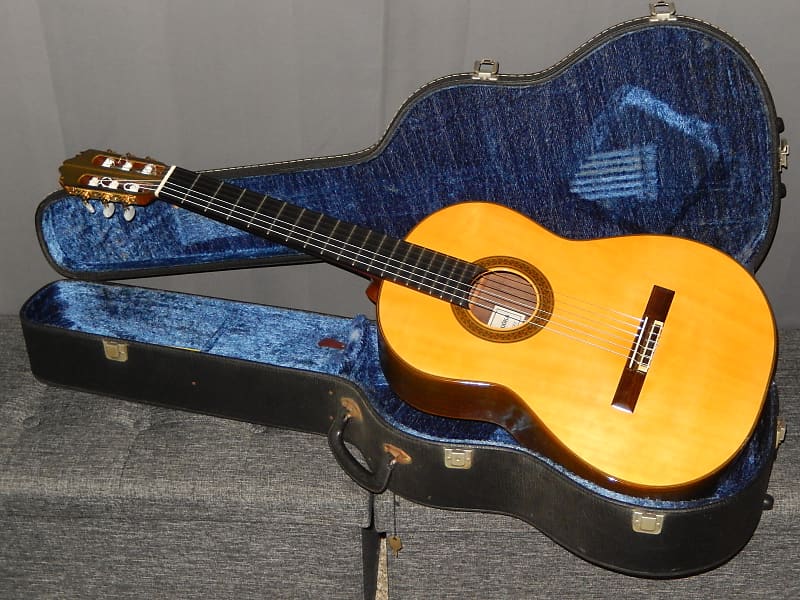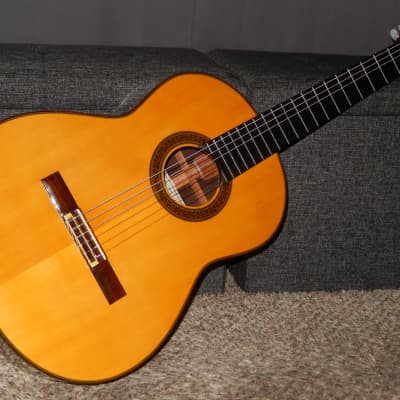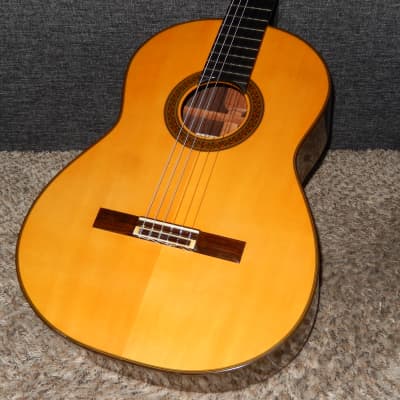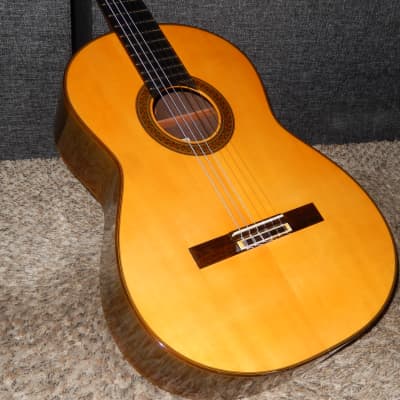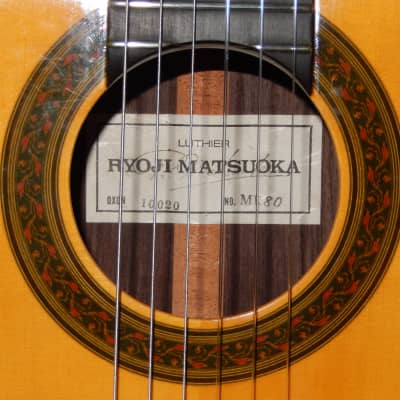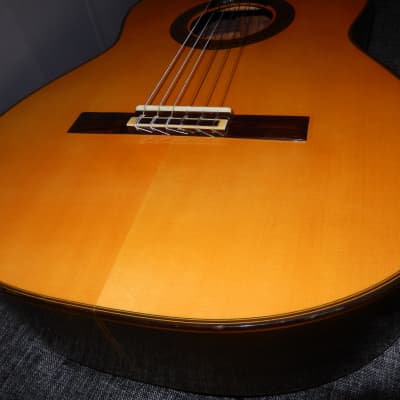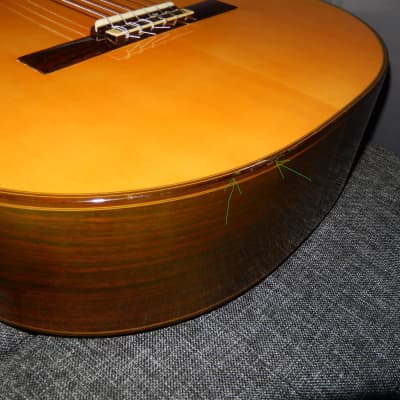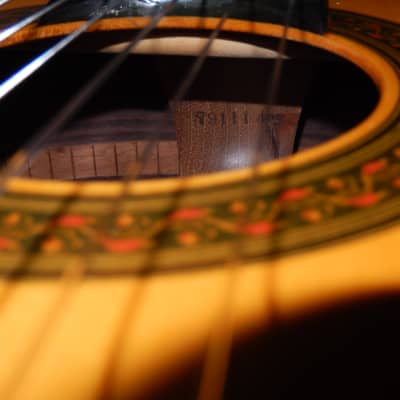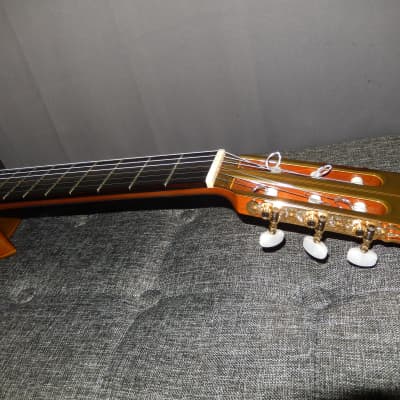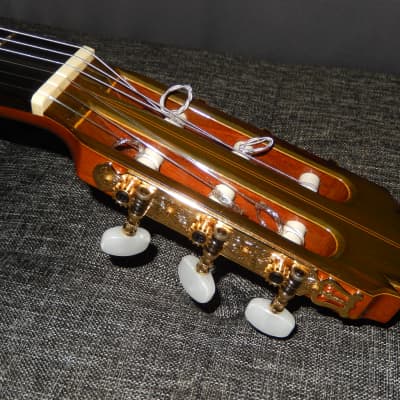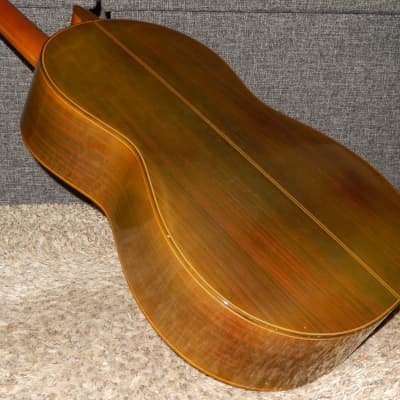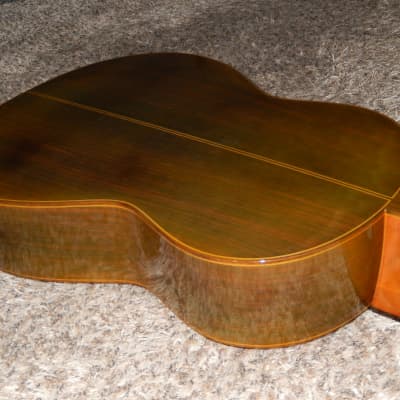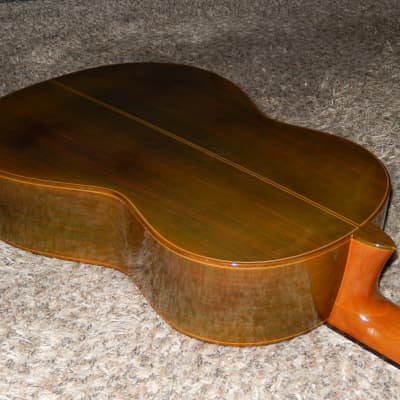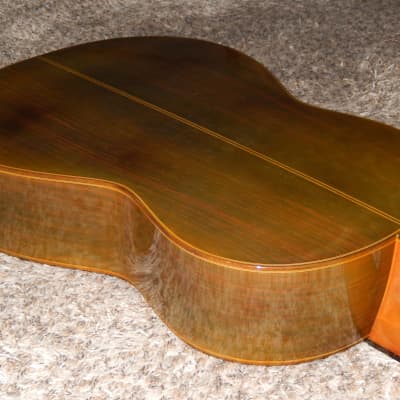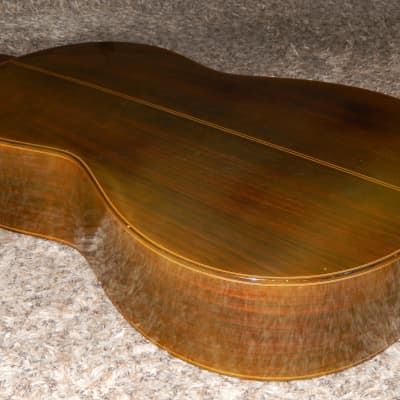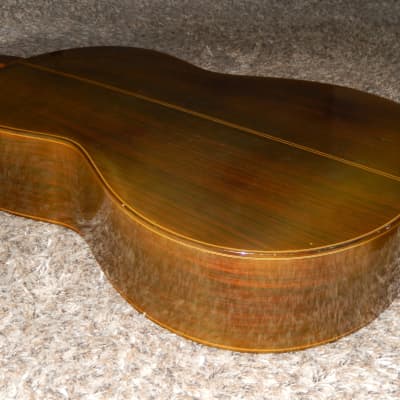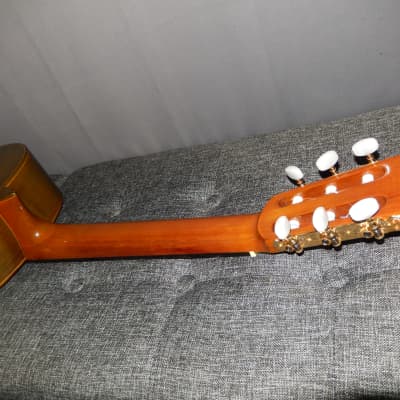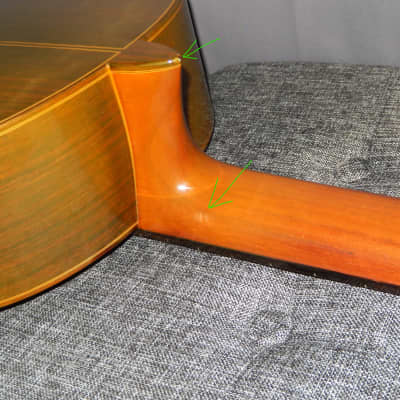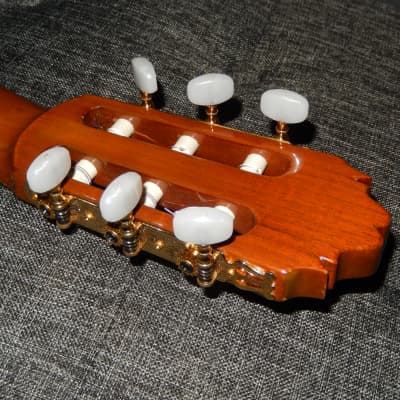Several hundred guitars I have sold in the past are presented at Facebook.com/Victors.Guitar.Library.
Ryoji Matsuoka MR80 A.D. 1979
This guitar was handmade and signed by Master Luthier Ryoji Matsuoka in 1979. It was a midrange model in Matsuoka’s lineup.
During that era the top-of-the line models were No150 (Ramirez style headstock, Matsuoka’s bracing), (Hauser style) MH150, (Jose David Rubio style) MR150, and (Fleta style) MF150, all priced 150 000 yen.
The second from the top models were No100, MH100, MR100 and MF100, being priced 100 000 yen.
All these Matsuoka guitars were greatly underpriced if compared with instruments made by most prominent Japanese luthiers of that era.
In terms of tonality these Rubio models are far superior to all other Matsuoka models.
This (priced 80 000 yen) MR80 guitar can easily challenge many guitars sold by more prominent Japanese makers for 100 000 – 150 000 yen.
During 1980s Ryoji Matsuoka was correcting his pricing and by 1990 his top models were priced 300 000 yen. Yet often they were no match to those 150 000 yen models from the late 1970s.
Hauser, Jose Rubio, and Fleta models were introduced by Matsuoka in the mid1970s. While his workshop continued making Hauser style models until its closure in 2014, Jose Rubio and Fleta style models were made only until early 1980s, and always in very limited numbers.
Currently similar class guitars made in Japan with any Rosewood b/s are priced $3500USD or more. Believe it or not, this MR80 guitar from 1979 is of very similar class as many “hand made in Spain” guitars sold in USA at $5000 level.
Its sound is simply gorgeous. It offers an impressive volume combined with a sweet, lyrical, and rich tonality. Basses are deep yet relatively clean. Trebles are sweet and glassy, with their own overtones, very clear and well separated. All notes are magnified by quite extended sustain.
It is very likely that in the early 2010s Matsuoka’s workshop was already producing losses. Soon after Ryoji’s death in September 2014, his workshop was closed for good, and production of “Matsuoka” guitars moved to China.
The overall condition of this guitar can be described as “excellent for its age”. Although there are few very minor imperfections visible on its body (few tiny dents along its edges, one dent on the very tip off the neck’s foot, light dent at the base of the neck, and an attrition at the left bottom of the soundboard being the most “serious damage”), excellent condition of the soundboard, fingerboard and frets suggest that this guitar hasn’t been played a lot over its life span.
Very common on Matsuoka guitars from that era finish cloudiness is greatly exaggerated on my pictures. In regular light it all appears much milder.
Specifications:
Top: Very Fine Solid Spruce/Rubio style bracing/lacquer
Back & Sides: Solid Indian Rosewood/ lacquer
Neck: Mahogany
Fingerboard: Ebony
Scale: 650 mm
Nut width: 51.5 mm
Strings: Savarez Cristal High Tension
The action is currently set to 3.80 mm under E6 and 3.00 mm under E1 with plenty of extra room on the saddle.
This guitar will be shipped in used Hard Shell Case.
When contemporary Japanese luthiers are using 40+ years old soundboards to make “all solid woods” guitar it is priced at least $5000USD. Guitars with artificially aged (“baked”) soundboards are priced at least $4500USD. Solid top models with 40+ years old soundboards are priced at least $3500USD. American, Australian and European luthiers usually charge 50% more.
It is a matter of basic education (not beliefs) to realize that 50+ years old soundboard of this guitar alone is worth $2500USD.
Real Value of Japanese Vintage Guitars
The key to understand value of vintage Japanese guitars is to acknowledge galloping price inflation (devaluation of Japanese yen) during 1960s & 1970s. This inflation slowed down in 1980s.
During 1960s and most of 1970s model numbers of Japanese guitars were strictly interconnected with their prices in Japanese yen. By early 1980s and during following decades model numbers were no longer strictly associated with their prices. Some Japanese guitar makers introduced model names instead of model numbers. Others were still using model numbers with addition of letters and/or other symbols.
It is then important to understand that two Yamaha GC10 guitars made 10 years apart are two instruments of totally different class. The same applies to any other Japanese maker/brand.
The logical way to estimate the true class of any given Japanese made instrument is to compare its price with the average annual salary of wage workers in Japanese private sectors. This salary was: 450 600 yen in 1965 - 825 900 yen in 1970 - 1 868 300 yen in 1975 - 2 689 000 yen in 1980 - 3 163 000 yen in 1985 - 3 761 000 yen in 1990 - 4 107 000 yen in 1995 - 4 082 000 yen in 2000.
Any guitar priced 100 000 yen in 1970 (labelled as No10 or No100) would be priced 200 000 yen in 1975 (relabeled to No20, No200 or 2000), 300 000 yen in 1977 (labelled as No3, No30 or 3000) and 500 000 yen by 1985 (labelled as No50 or 5000).
Starting in 1977 Masaru Kohno introduced his new models No40 priced 400 000 yen and No50 priced 500 000 yen. By early 1980s Kohno started using model names instead of numbers and was steadily raising their prices without changing model labeling. His very top model 50 became model “Special”, and a decade later it became model “Maestro”. Naturally, all other Japanese guitar makers were doing similar pricing (labelling) upgrades.
Knowing all of that, you can bet on that Masaru Kohno No50 made in 1982 is practically the same grade instrument as Kohno No20 made in 1972, or Kohno no 30 made in 1975.
In early 1970s the lowest Ryoji Matsuoka (all plywood) model was 10, followed by (solid top) models 15, 20, 25, 30, 40, 50, 60, 80 and (all solid woods) models 100 and 150. Models 50, 60 and 80 were made with non-solid figured Brazilian Rosewood (double) back and sides and top model 150 was the only one made with solid figured Brazilian Rosewood b/s.
In 1980 the lowest Matsuoka model was (all plywood) 20, followed by (solid top) models 30,40,50, 60 and all solid woods models 80,100,150 and 200. By 1990 the lowest Matsuoka model was M40 and the highest was M300. By 2010 the lowest Matsuoka model was M50 and the top model was M270.
You can bet that Ryoji Matsuoka model 50 from 1980 is of the same grade as model M100 from 2000, model 100 from 1980 is of the same grade as model M150 from 2000, model 150 from 1980 is of the same grade as M200 from 2000 and model 200 from 1980 is of the same grade as model M300 from 2000.
It is important to mention that if modern era luthiers are using 40+ years old woods to make an “all solid” wood classical guitar, its price is minimum $8000.
All vintage guitars made with Brazilian Rosewood are especially precious, including those made straight grain varieties and those with non-solid b/s.
Because response and tonal properties of Spruce soundboards are improving over time, long seasoned Spruces are far more precious than long seasoned Cedars.
It is not very difficult to find out what are current prices of such guitars made by world’s leading luthiers.
Some other relevant info:
Ryoji Matsuoka was well known Japanese guitar maker who has been producing guitars in Nagoya, Japan since the 1960s. Nagoya is Japan’s 4th largest city and a major industrial port city located on the main island of Honshu in Aichi prefecture.
The Nagoya/Aichi/Kani area (Kani is the prefecture next to Aichee) is one of Japan’s major musical instrument making centers. The city and the outlying areas have a long classical guitar making history with many small shops producing guitars. Major guitar and violin makers include Matsumoku Industrial, Suzuki, Takaharu, Sada Yairi, Kazuo Yairi (Kani), Daion, Yamaki, Ibanez/Hoshino, and Ryoji Matsuoka. Additionally, there are numerous small guitar shops and factories that contract to larger firms, such as Yamaha in Hamamatsu.
The Ryoji Matsuoka guitar works was a small scale guitar manufacturer with less than 15 employees. For a few years during the 1960s and early 1970s, Matsuoka produced the higher end Aria guitar models for Shiro Arai, founder of Aria. These Aria models either have Ryoji Matsuoka's name on the label or are marked RM with a red stamp on the neck block. Matsuoka also made some models for Ibanez, including a few steel string flatop and archtop models.
During the early 1970s, Matsuoka produced Fleta, Hauser, Kohno and Rubio. The copies of Kohno guitars with 2 ebony strips in the necks and higher grade spruce tops were made in much greater numbers than copies of other luthiers. They were also sold at higher price.
From 1975 to 1980 the company produced their own line of guitars: the concert, artist and artisan series.
The Concert series includes the M20 (solid spruce top, nato neck), M30 (solid spruce top, mahogany neck), M40 (solid spruce top, mahogany neck). All 3 models have laminated rosewood back and sides and rosewood fingerboards.
The Artist Series includes the M50 and M60. These guitars have better quality spruce tops and were made in several versions. Some of them, less expensive versions, were made with laminated Indian Rosewood or laminated Jacaranda back and sides, ebony fingerboards and plain neck. On the other end of the spectrum there were also all solid versions with Solid Indian rosewood or solid Jacaranda back and sides, with one or double Ebony reinforcement in the neck.
The Old World Artisan Series includes the M70 and M80, made with all solid woods and one-piece mahogany necks.
During the 1980s and early 1990s, Matsuoka models included the M50, M60, M70, M80, M100, M150, M200, and M300 with Ramirez style headstock and models MH100, MH150, MH200, MH300 with Hauzer style headstock. All of them were made with solid Spruce tops. M50, M60, M70 were made either with laminated back and sides or as all solid guitars. All other models were all solid wood guitars.
In the late 1990-ties models M65 and M75 with Cedar tops were added to the production line mostly with laminated back and sides.
To make matters little more complicated, by the end of 1990-ties some Spruce top models were also made with Cedar top without any change on the label. So we can for example encounter model M60 with either Spruce or Cedar top. Most likely each guitar was sold with attached precise specification.
Since early 1990-ties Matsuoka has also been making guitars for Aranjuez label (launched in early 1970s by Masaru) and lower priced cosmetic copies of a Mathias Dammann classical guitars (they were not exact copies). The top Aranjuez model M720 has been made in cooperation with Kohno/Sakurai workshop. Masaru Kohno and later Masaki Sakurai were making tops with their superb bracing, while Ryoji Matsuoka was responsible for all other parts and final assembly. This cooperation continues until today between Toshiaki Matsuoka and Masaki Sakurai. These M720 guitars with Matsuoka and Sakurai labels offer exceptional quality of sound at moderate price. They are sold at Guitar Salon International in Santa Monica, CA for $2700.
Since 1986 Matsuoka Co. was managed by Ryoji's son and also great luthier Toshiaki Matsuoka. Soon after Ryoji's death in September of 2014, his workshop's website disappeared from internet and production of "made in Japan" Matsuoka guitars ended. As of today, all brand new Matsuoka guitars available on Japanese market are made in China. Available models are: M70(MH70) through M180(MH180).
Important message for Australian buyers:
USPS International Priority Mail packages destined for Australia have quite restricted size (max. length is 42” and max. length + girth is 97”). For these reasons I must use the case that is no longer than 41” and therefore it may be different than the one you see on the pictures. You should ask me for any other details prior to making a purchase.
